
10 Project Management Best Practices for 2025
Unlock success with our 2025 guide to project management best practices. Learn 10 actionable strategies to streamline workflows and boost team efficiency.
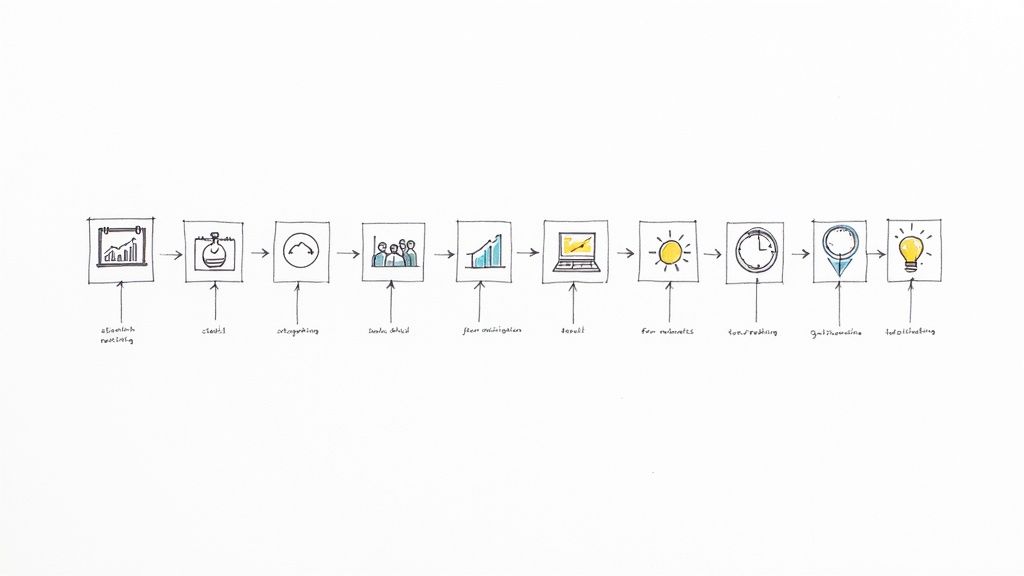
In 2025, successful project delivery hinges on more than just meeting deadlines and budgets. It demands a strategic blend of proven principles and adaptive execution, especially as teams become more distributed. Sticking to established project management best practices is the bedrock of success, but how do you apply them effectively without drowning in administrative overhead? Mastering project management in a hybrid world requires specific strategies, as the unique complexities of distributed teams present obstacles that need direct solutions. For those looking to dive deeper into this specific area, learning about overcoming remote team challenges can provide a significant advantage.
The key to efficiency lies in integrating these practices seamlessly into your team's daily workflow. This guide moves beyond theory and dives into 10 essential best practices that separate high-performing project teams from the rest. We will explore each principle in depth, from defining scope and managing stakeholders to implementing robust risk management and building effective communication plans.
More importantly, we'll provide actionable steps and show how lightweight tools that enhance your existing ecosystem, like Tooling Studio's integrations for Google Workspace, can transform principles into reality. You'll learn how to centralize your efforts, streamline execution, and eliminate the constant friction of switching between applications, all within the familiar environment your team already uses every day.
1. Define Clear Project Scope and Requirements
One of the most foundational project management best practices is establishing a well-defined project scope from the very beginning. This involves creating detailed project charters and scope statements that clearly articulate what will and won't be included. Think of it as drawing the map before starting the journey; it ensures every stakeholder understands the destination and the path to get there.
How It Works and Why It's Crucial
A clear scope prevents the dreaded "scope creep," where uncontrolled changes and additions derail timelines and budgets. By defining deliverables, boundaries, and requirements upfront, you create a single source of truth that aligns the project team and stakeholders. This was critical for massive undertakings like the Burj Khalifa, where every cubic meter of concrete and pane of glass was meticulously planned.
To implement this, you can:
- Involve Stakeholders Early: Host kickoff meetings to gather requirements from all key parties.
- Use SMART Criteria: Ensure project objectives are Specific, Measurable, Achievable, Relevant, and Time-bound.
- Establish a Change Control Process: Create a formal system for requesting, evaluating, and approving any changes to the scope.
The following infographic highlights the direct benefits of investing time in this initial phase.
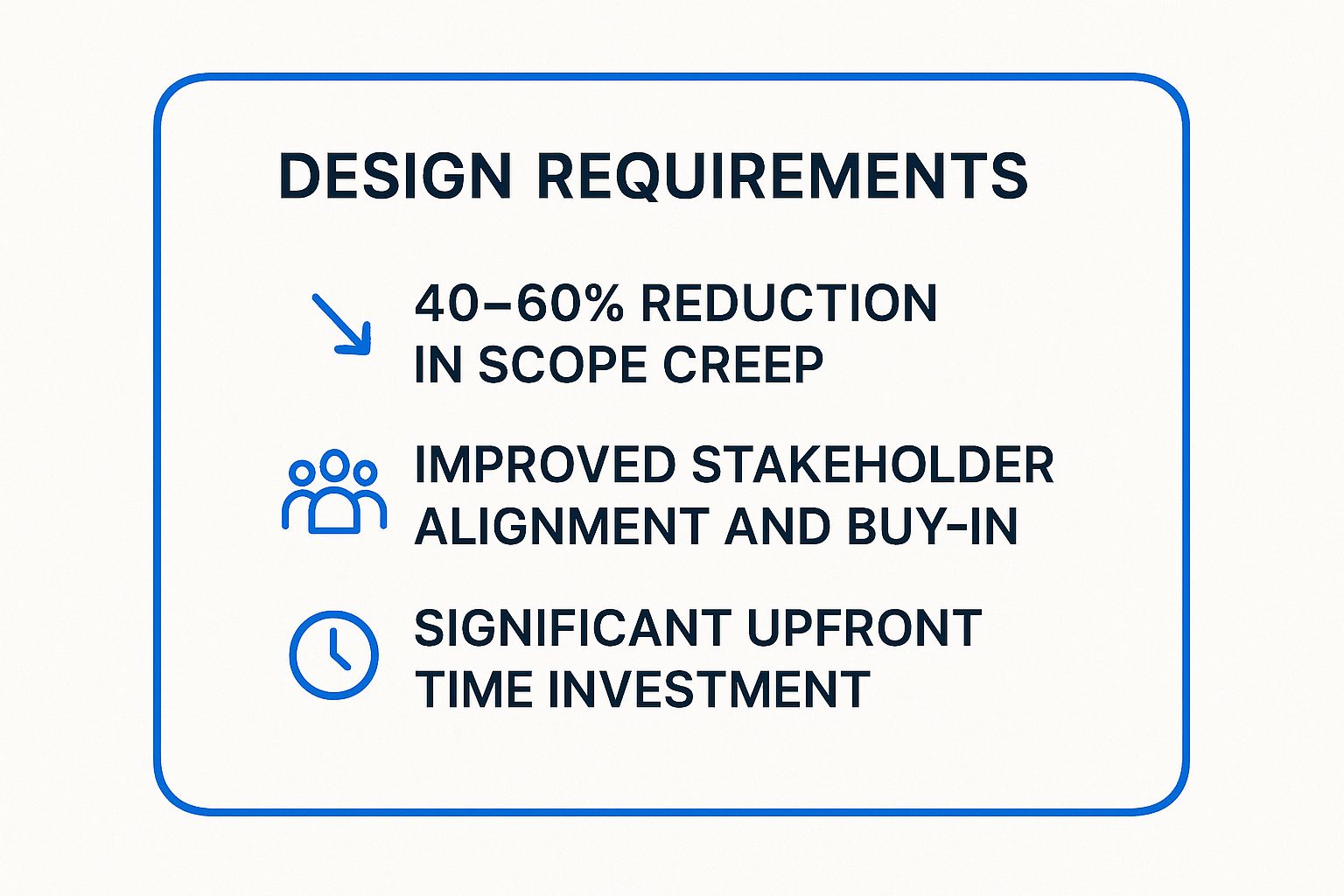
As the data shows, the significant upfront time investment pays off by drastically reducing scope creep and improving stakeholder buy-in. To maintain this clarity, Tooling Studio helps by centralizing all scope-related documents and communications directly within Google Workspace. You can link a definitive Google Doc scope statement to your project board, ensuring the team always references the correct version. To dive deeper into this topic, explore our tips for preventing project bloat and learn more about managing scope creep.
2. Implement Effective Stakeholder Management
Another cornerstone of project management best practices is the systematic identification, analysis, and engagement of stakeholders. This involves mapping out everyone who can impact or is impacted by the project, from the core team to external regulators. A robust stakeholder management plan acts as your diplomatic strategy, ensuring you communicate the right information to the right people at the right time.
How It Works and Why It's Crucial
Effective stakeholder management builds trust, fosters support, and mitigates risks that arise from misalignment or opposition. By understanding each stakeholder's influence and interest, you can tailor your engagement strategy to secure buy-in and manage expectations proactively. This was essential for the London 2012 Olympics, which successfully managed over 200 distinct stakeholder groups, from international athletic committees to local residents.
To implement this, you can:
- Create a Stakeholder Map: Plot stakeholders on a grid based on their influence and interest to prioritize engagement efforts.
- Develop a Communication Plan: Define the frequency, channel, and content for communications with each stakeholder group.
- Document and Address Feedback: Maintain a log of all stakeholder concerns and the actions taken to resolve them.
This systematic approach transforms potential obstacles into project advocates. With Tooling Studio, you can manage stakeholder communications directly from your Google Workspace. For instance, you can use Google Sheets to create a dynamic stakeholder map and link specific contacts or email threads from Gmail to your project board, ensuring all interactions are tracked and visible to the team. This keeps your engagement strategy organized and actionable. To explore this further, check out our guide on leveraging Google tools for stakeholder engagement.
3. Adopt Agile and Iterative Methodologies
Shifting from rigid, linear project management to a more flexible model is a game-changing project management best practice. Adopting Agile and iterative methodologies like Scrum or Kanban allows teams to build, test, and deliver work in small, incremental cycles. This approach prioritizes collaboration, continuous feedback, and the ability to adapt to changes quickly, ensuring the final product truly meets user needs.
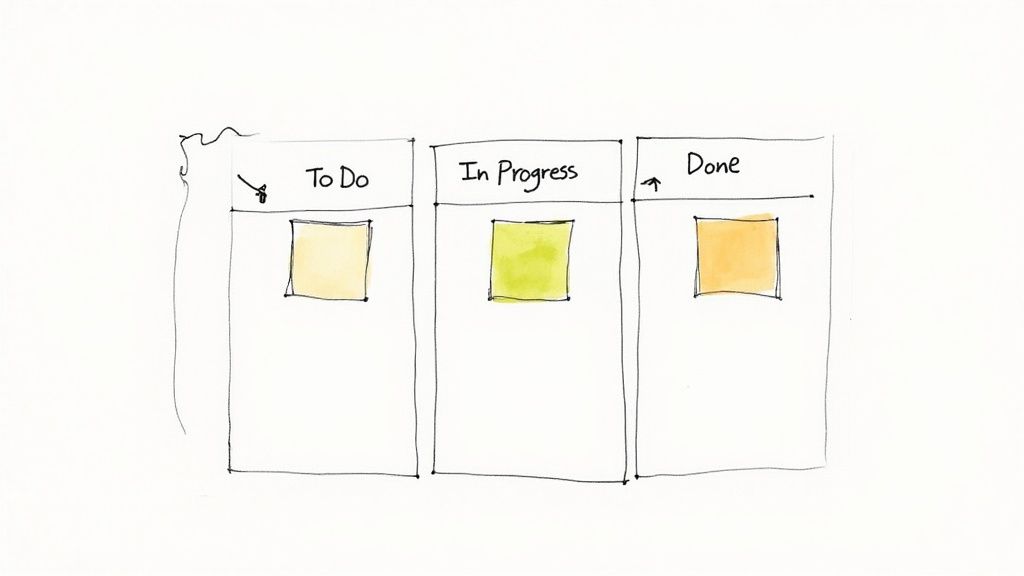
How It Works and Why It's Crucial
Agile breaks down large projects into manageable "sprints" or iterations, each resulting in a potentially shippable increment of the product. This iterative process, seen in companies like Spotify with their squad-based development, empowers teams to respond to evolving requirements without derailing the entire project. It fosters a culture of continuous improvement and customer-centricity. For teams adopting these methods, selecting the right platforms is crucial for facilitating practices like Agile project management and daily stand-ups.
To implement this, you can:
- Start with Pilot Projects: Test Agile on a smaller, lower-risk project before a full-scale organizational rollout.
- Invest in Team Training: Ensure everyone understands Agile principles, roles (like Scrum Master), and ceremonies (like retrospectives).
- Use Visual Management Tools: Implement Kanban boards to visualize workflow, limit work-in-progress, and identify bottlenecks.
- Establish a "Definition of Done": Create clear, agreed-upon criteria for when a task or user story is officially complete.
The video below provides an excellent overview of the Scrum framework, one of the most popular Agile methodologies.
To support Agile workflows, Tooling Studio allows you to create dynamic Kanban boards directly within Google Workspace. You can turn emails into tasks and manage your sprints using a visual board that integrates seamlessly with your Gmail and Google Drive, keeping your team aligned and your progress transparent. This unified approach simplifies task tracking and collaboration for every sprint.
4. Establish Robust Risk Management Processes
Another essential project management best practice is building a proactive system for managing uncertainty. This means going beyond simply hoping for the best and instead methodically identifying, assessing, and mitigating potential risks before they can disrupt your project. It's about creating a safety net that protects your timeline, budget, and objectives from unforeseen events.
How It Works and Why It's Crucial
A robust risk management process involves creating a comprehensive risk register to track potential threats and opportunities. This framework allows you to prioritize risks based on their likelihood and potential impact, ensuring you focus your resources where they matter most. This level of foresight was instrumental in complex infrastructure projects like the Channel Tunnel, where engineers used comprehensive risk frameworks to anticipate everything from geological instability to logistical failures.
To implement this, you can:
- Practice 'Pre-Mortem' Exercises: Gather your team to imagine the project has failed and work backward to identify all the reasons why.
- Assign Clear Risk Owners: Make specific team members accountable for monitoring and mitigating assigned risks.
- Use Historical Data: Analyze past projects to identify common pitfalls and recurring challenges.
Proactively managing risk transforms uncertainty from a threat into a manageable variable. With Tooling Studio, you can create a dedicated Google Sheet to serve as your project’s risk register. By linking this Sheet directly to your project board, you ensure that risk assessment remains a visible and ongoing part of the team's workflow, not just a one-time exercise. For a deeper look at identifying project threats, check out our guide on how to run a project pre-mortem.
5. Develop Comprehensive Communication Plans
Another cornerstone of project management best practices is the development of a strategic communication plan. This isn't just about sending emails; it's about ensuring the right information reaches the right people at the right time through the most effective channels. A well-crafted plan dictates who needs what information, when they need it, and how it will be delivered, creating a predictable and transparent information flow.
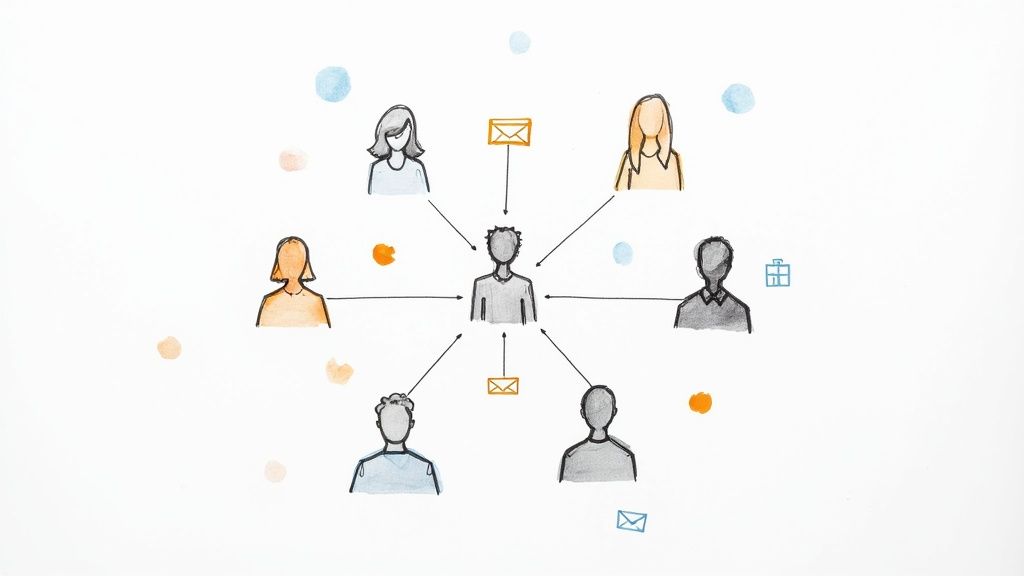
How It Works and Why It's Crucial
A formal communication plan prevents misunderstandings, keeps stakeholders engaged, and minimizes project-derailing rumors or misinformation. For example, global software development teams rely on multi-channel strategies to coordinate across time zones, while Apple’s famously secretive yet structured internal communications ensure alignment during new product development without leaks. This proactive approach builds trust and maintains momentum.
To implement this, you can:
- Identify Stakeholder Needs: Map out all project stakeholders and determine their specific communication requirements, including frequency, format, and level of detail.
- Establish Communication Channels: Define primary channels for different types of communication, such as daily stand-ups for team updates, email for formal announcements, and a shared drive for documentation.
- Create a Communication Matrix: Document the plan in a simple matrix that outlines the what, who, when, and how for all project communications.
A clear communication strategy is non-negotiable for keeping complex projects on track. Tooling Studio simplifies this by integrating directly with your primary communication tools in Google Workspace. You can automate status updates via Gmail, schedule recurring project review meetings in Google Calendar, and use shared Google Drive folders as the central repository for all project communications, ensuring everyone stays informed without leaving their familiar ecosystem. For more on this, check out our guide on enhancing team collaboration.
6. Use Data-Driven Decision Making and KPIs
Shifting from intuition to evidence is a hallmark of modern project management best practices. This involves systematically measuring and analyzing project performance using key performance indicators (KPIs) and data analytics. It means making objective decisions based on quantitative facts, not assumptions, which leads to more accurate project tracking and significantly improved outcomes.
How It Works and Why It's Crucial
Data-driven decision-making provides an impartial view of project health, allowing you to identify risks, spot opportunities, and allocate resources more effectively. Pioneered by figures like W. Edwards Deming and popularized by methodologies like Google’s OKR (Objectives and Key Results) framework, this approach replaces guesswork with certainty. By tracking the right metrics, you can answer critical questions about budget adherence, timeline progress, and team productivity with confidence.
To implement this, you can:
- Select a Few Key Metrics: Focus on 5-7 vital KPIs like Cost Performance Index (CPI) or Schedule Performance Index (SPI) that truly reflect project success.
- Automate Data Collection: Use tools and integrations to automatically gather data from various sources, reducing manual effort and human error.
- Utilize Visual Dashboards: Present data in easily digestible formats like charts and graphs to facilitate quick interpretation and decision-making.
Effective data analysis hinges on clear communication. To ensure your projects stay on track and deliver measurable results, leveraging effective project reporting is critical. You can explore some practical project management reporting examples that help monitor progress and inform decisions. With Tooling Studio, you can export project data directly to Google Sheets, creating dynamic, real-time dashboards that transform raw numbers into actionable insights within your familiar Google Workspace environment.
7. Implement Strong Change Management
Change is an unavoidable reality in any project, but how you manage it separates success from failure. Implementing strong change management is a core project management best practice that provides a structured approach for handling modifications to scope, schedule, or budget. This isn't about preventing change; it's about controlling it to maintain project integrity and stakeholder alignment.
How It Works and Why It's Crucial
A formal change management process ensures that every proposed alteration is documented, assessed, and approved before implementation. This systematic review prevents chaotic adjustments that can compromise project goals. For example, software giants like Microsoft use formal change management for product updates to ensure every modification aligns with the overall strategy and doesn't introduce new bugs. Similarly, construction projects rely on detailed change orders to analyze the impact of any deviation from the original blueprint.
To implement this, you can:
- Establish Clear Change Request Templates: Use a standardized form to capture all necessary details for a proposed change.
- Define Decision-Making Authority: Clarify who has the authority to approve changes of different magnitudes (e.g., minor vs. major).
- Assess Full Impact: Analyze how a change affects not just scope and budget, but also schedule, quality, and risk.
- Communicate Decisions Promptly: Inform all affected parties about approved or rejected changes to ensure everyone remains aligned.
By formalizing this process, you create a transparent and predictable system. With Tooling Studio, you can manage change requests directly within your Google Workspace environment. A shared Google Form can serve as your change request template, with submissions automatically creating tasks in Tooling Studio for review and approval. This keeps the entire change lifecycle documented and accessible right where your team works. To learn more about integrating these workflows, discover how to streamline processes with Tooling Studio.
8. Build and Maintain High-Performing Teams
A project’s success is directly tied to the people executing it, making team development one of the most critical project management best practices. This involves more than just assigning tasks; it’s about intentionally creating a cohesive unit with clear roles, strong communication, and a shared commitment to the project's goals. A high-performing team is one where members trust each other, challenge ideas constructively, and are collectively accountable for outcomes.
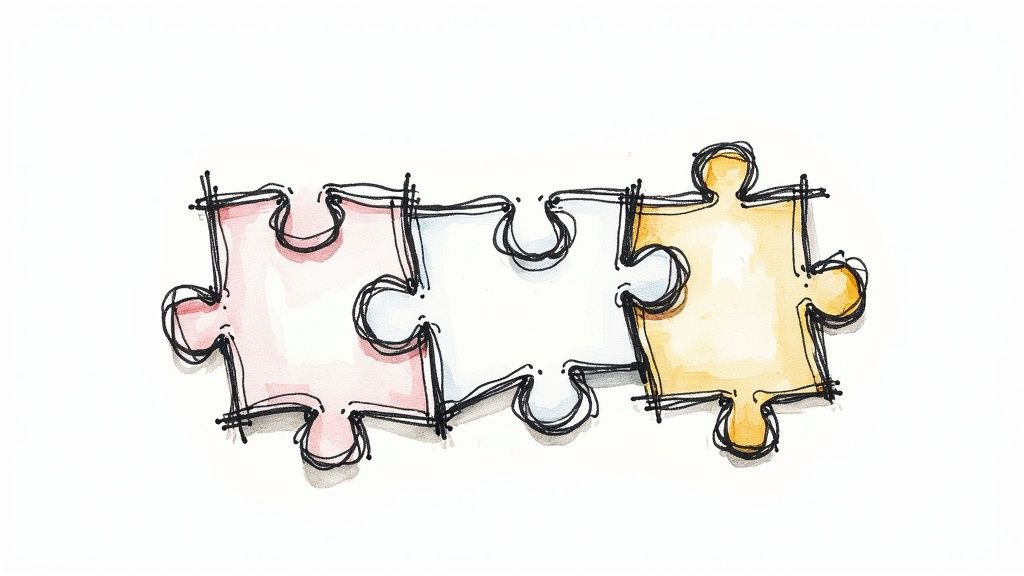
How It Works and Why It's Crucial
This practice moves beyond resource allocation to focus on team dynamics and psychological safety, a concept famously identified by Google's Project Aristotle as the single most important factor in team effectiveness. When team members feel safe to take risks and be vulnerable, they are more likely to innovate and collaborate. This was evident in NASA's Apollo missions, where exceptional teamwork under immense pressure led to historic achievements.
To cultivate a high-performing team, you should:
- Establish Clear Norms: Co-create team charters that define communication protocols, meeting cadences, and decision-making processes.
- Promote Psychological Safety: Encourage open dialogue, treat failures as learning opportunities, and ensure every voice is heard and respected.
- Address Conflict Constructively: Don't let disagreements fester. Implement a process for raising and resolving conflicts early and directly.
Tooling Studio supports team cohesion by centralizing project communication and documentation. By linking a Google Sheet with a RACI matrix (Responsible, Accountable, Consulted, Informed) directly to your project, everyone maintains clarity on their roles. This transparency is key to building trust and you can discover new ways to measure team productivity.
9. Utilize Appropriate Project Management Tools and Technology
Selecting the right technology stack is a critical project management best practice that directly impacts efficiency and outcomes. This involves strategically choosing software that fits your team's workflow, rather than forcing your team to adapt to a rigid tool. The goal is to enhance collaboration, automate repetitive tasks, and provide a clear view of project progress.
How It Works and Why It's Crucial
The right tools act as a central nervous system for your project, connecting people, data, and processes. Without them, teams often rely on fragmented spreadsheets and endless email chains, leading to data silos and miscommunication. For example, tech giants like Spotify successfully manage complex agile projects by integrating specialized tools like Jira and Slack, creating a seamless flow of information. This unified approach ensures everyone has access to real-time data, from sprint planning to deployment.
To implement this, you can:
- Match Tools to Team Maturity: Select software that aligns with your team's current processes and skill level. Don't overcomplicate things.
- Prioritize Integration: Choose tools that connect with your existing systems to create a single source of truth and avoid data duplication.
- Ensure Proper Onboarding: Provide comprehensive training to ensure every team member can leverage the tool's full potential.
A well-chosen toolset streamlines operations and provides clarity. For teams embedded in Google Workspace, Tooling Studio enhances this ecosystem by turning your existing apps into a powerful project hub. It integrates task management directly into Gmail, Google Docs, and Sheets, eliminating the need to switch between different platforms. To see how you can unify your workflow, explore our guide on leveraging Google Workspace for project management.
10. Conduct Regular Project Reviews and Lessons Learned
A project isn’t truly complete until the team has reflected on its journey. This is why conducting systematic project reviews and lessons learned sessions is one of the most impactful project management best practices. It involves a structured evaluation of the project's performance, processes, and outcomes to capture valuable knowledge for the future. Think of it as organizational learning in action, ensuring that every project, successful or not, contributes to the company's collective wisdom.
How It Works and Why It's Crucial
This practice prevents teams from repeating the same mistakes and helps institutionalize successes. By systematically documenting what went right and what went wrong, you create a powerful knowledge base. NASA’s extensive post-mission reviews are a prime example, analyzing every detail to refine processes for future missions. Similarly, agile teams use sprint retrospectives to continuously improve their workflow from one cycle to the next. The goal is to foster a culture of continuous improvement.
To implement this, you can:
- Establish a Blame-Free Environment: The focus must be on learning, not assigning fault. This encourages honest and open feedback.
- Document Both Wins and Losses: Successes are just as important to analyze as failures, as they provide repeatable formulas.
- Make Findings Accessible: Store lessons learned in a central, searchable repository.
- Assign Ownership for Improvements: Ensure that recommendations from these sessions are assigned to specific team members to be implemented.
For a process so reliant on documentation and collaboration, a unified platform is key. Tooling Studio facilitates this by allowing you to create a dedicated Google Doc for each project's lessons learned. You can attach this living document directly to the project board, making it easy for the team to contribute insights in real-time and for future project managers to access a complete history. To further refine your review process, consider our guide on how to run effective team meetings.
Project Management Best Practices Comparison
| Approach | Implementation Complexity 🔄 | Resource Requirements ⚡ | Expected Outcomes 📊 | Ideal Use Cases | Key Advantages ⭐ / Tips 💡 |
|---|---|---|---|---|---|
| Define Clear Project Scope and Requirements | Medium-High (detailed upfront work) | Moderate (stakeholder involvement, documentation) | Reduces scope creep by 40-60%, improves alignment | Large, complex, fixed-scope projects | ⭐ Prevents scope creep; 💡 Use SMART objectives; involve all stakeholders |
| Implement Effective Stakeholder Management | High (requires continuous effort) | High (ongoing engagement, communication) | Increases project success by up to 50% | Projects with diverse or many stakeholders | ⭐ Boosts support and decision quality; 💡 Map and update stakeholders regularly |
| Adopt Agile and Iterative Methodologies | Medium-High (cultural and process shift) | Moderate-High (training, team involvement) | 25-50% faster time-to-market, higher satisfaction | Dynamic, evolving projects | ⭐ Fast delivery and adaptation; 💡 Start with pilots, use retrospectives |
| Establish Robust Risk Management Processes | Medium-High (requires expertise) | Moderate (risk workshops, tools) | Reduces failure by 30-40%, lowers costs/delays | High-risk or complex projects | ⭐ Proactive risk control; 💡 Assign risk owners, update regularly |
| Develop Comprehensive Communication Plans | Medium (planning and maintenance) | Moderate (tools, protocols, reporting) | Reduces conflicts by 60%, improves satisfaction | Projects needing active coordination | ⭐ Clear info flow; 💡 Tailor messages, use visual dashboards |
| Use Data-Driven Decision Making and KPIs | Medium (setup dashboards, metrics) | Moderate-High (tools, training) | Improves success 25-35%, early issue detection | Data-rich, measurable projects | ⭐ Objective decisions; 💡 Select key metrics, automate data collection |
| Implement Strong Change Management | Medium (process design and enforcement) | Moderate (boards, documentation) | Prevents uncontrolled scope changes | Projects with frequent change requests | ⭐ Controls scope creep; 💡 Define authority, assess all impacts |
| Build and Maintain High-Performing Teams | High (ongoing development effort) | High (training, leadership, culture building) | Increases productivity 20-25%, improves quality | Complex, collaborative projects | ⭐ Boosts innovation and retention; 💡 Provide feedback, foster trust |
| Utilize Appropriate Project Management Tools and Technology | Medium (tool selection and training) | Moderate-High (licenses, onboarding) | Increases productivity 15-30%, improves visibility | Remote or complex projects | ⭐ Enhances collaboration; 💡 Match tools to needs, evaluate regularly |
| Conduct Regular Project Reviews and Lessons Learned | Medium (scheduled reviews and documentation) | Moderate (time for sessions and documentation) | Improves future success 20-30%, prevents repeated mistakes | Projects valuing continuous improvement | ⭐ Facilitates organizational learning; 💡 Create blame-free culture, assign ownership |
Integrating Best Practices for Lasting Success
Navigating the complexities of modern projects requires more than just a checklist. The journey from a promising idea to a successful outcome is built upon a foundation of interconnected principles. As we've explored, mastering the art of project management isn't about perfectly executing a single practice in isolation. Instead, it’s about skillfully weaving these ten essential threads into a cohesive, resilient, and adaptive project management strategy.
Think of it as building an engine. A clear project scope is the chassis, providing structure and direction. Agile methodologies and iterative development are the pistons, driving momentum and allowing for quick adjustments. Robust risk management acts as the braking system, providing control when navigating uncertainty, while a comprehensive communication plan serves as the oil, ensuring every moving part works together smoothly and without friction. Each component is critical, and the failure of one can compromise the entire system. True project excellence emerges from the synergy between these elements.
From Theory to Tangible Results
The core takeaway is that adopting these project management best practices is a continuous journey, not a one-time destination. It's about cultivating a culture of clarity, collaboration, and continuous improvement. The most significant barrier to this culture is often friction caused by disjointed tools and workflows that pull teams out of their natural rhythm. This is where strategic technology integration becomes a game-changer.
By embedding project management functions directly within your team's existing digital hub, like Google Workspace, you dismantle these barriers. When creating a task from an email in Gmail or converting a Google Sheet row into a trackable item becomes a seamless, one-click action, you empower your team to focus on high-value work rather than administrative overhead. This integrated approach transforms best practices from abstract concepts into tangible, daily habits.
Your Actionable Path Forward
To begin implementing these concepts, don't try to boil the ocean. Start with a targeted approach:
- Assess Your Current State: Identify the one or two practices from this list that represent your team's most significant pain points. Is it scope creep? Poor communication? Inadequate risk planning?
- Implement a Focused Change: Introduce the corresponding best practice with clear guidelines. If communication is the issue, formalize your communication plan. If scope is the problem, implement a stricter change management process.
- Leverage Integrated Tooling: Use a tool like Tooling Studio's Kanban Tasks to centralize task management directly within Google Workspace. This provides immediate visibility and reinforces the new process without forcing a disruptive context switch.
- Measure and Iterate: Track the impact of this change. Are deadlines being met more consistently? Are stakeholders more aligned? Use these data-driven insights to refine your approach and then select the next practice to improve.
Ultimately, embracing these project management best practices is about creating an environment where predictability, efficiency, and success are the norms, not the exceptions. By building your team’s project management maturity one practice at a time, supported by technology that enhances rather than hinders your workflow, you pave the way for consistently delivering outstanding results and lasting value.
Ready to embed these best practices directly into your team's workflow? Discover how Tooling Studio transforms Google Workspace into a powerful, centralized hub for task management and sales CRM. Start streamlining your projects today and empower your team to achieve more with less friction.